Called the “California of Europe” and one of Europe’s most popular destinations, Portugal is home to picturesque neighborhoods, golden cliffs, and Port wine.
One week is enough time to visit the country’s charming and lively major cities and take day trips to top attractions.
My sister and I separately took a trip to Portugal in the fall and spring, and here, I share amazing things to do and our tips on optimizing your trip itinerary. This post covers:
- 🗓️ 7-day optimized itinerary
- ⭐️ Top attractions in the country
- 📍 Portugal map with key places
- 💎 Hidden gems & firsthand tips
- 🏠 Where to stay
- ✏️ Portugal trip planner
Planning a trip? Here’s what to know about Portugal.
Lists By Lukiih is readers-supported. When you buy with my affiliate link, I may earn a small commission. Thanks!
Portugal Itinerary Route
This itinerary takes you to some of Portugal’s best places:
- Lisbon – the capital and most-visited destination.
- Sintra – a picturesque fairy-tale-like town.
- Porto – the charming capital of the northern region.
- Douro Valley – the region exclusively producing Port wine.
About This Portugal Itinerary
This Portugal itinerary efficiently sequences attractions and activities the country is famous for. It gives you the opportunity to:
- Explore a vibrant metropolis with distinct neighborhoods
- Visit a city with castles, gardens, and palaces
- See several riverfront promenades
- Drink Port wine while visiting the valley that produces it
- Enjoy numerous sunset viewpoints
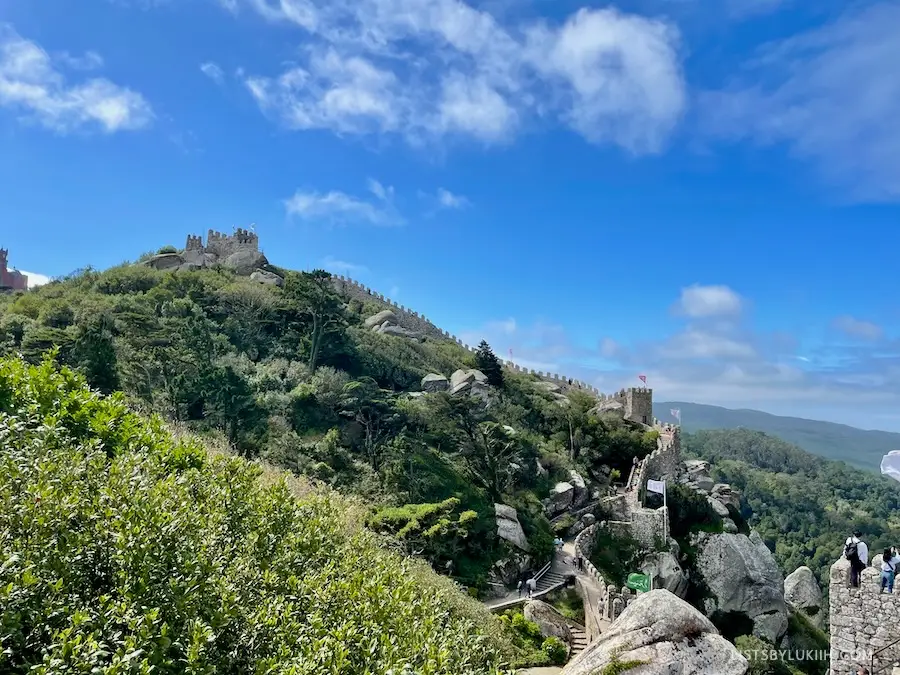
6 Essential Tips for Visiting Portugal
Before getting into the itinerary, here are practical tips to know when traveling to Portugal.
👟 1. Wear comfortable shoes as Portugal is very hilly.
Cities and towns are pedestrian-friendly but incredibly hilly, featuring cobblestone steps and narrow sidewalks. My sister wore Converse and got foot pain from all the walking.

🪑 2. Make restaurant reservations, especially for outdoor dining.
Getting outdoor seating is challenging when there’s pleasant weather, so reservations will save you some hassle. I spent more than an hour looking for outdoor dining options several times and wished I had booked reservations ahead.
Portugal’s pace of life is slower, and meals often take over an hour. No one is keen to rush out for the next customer.
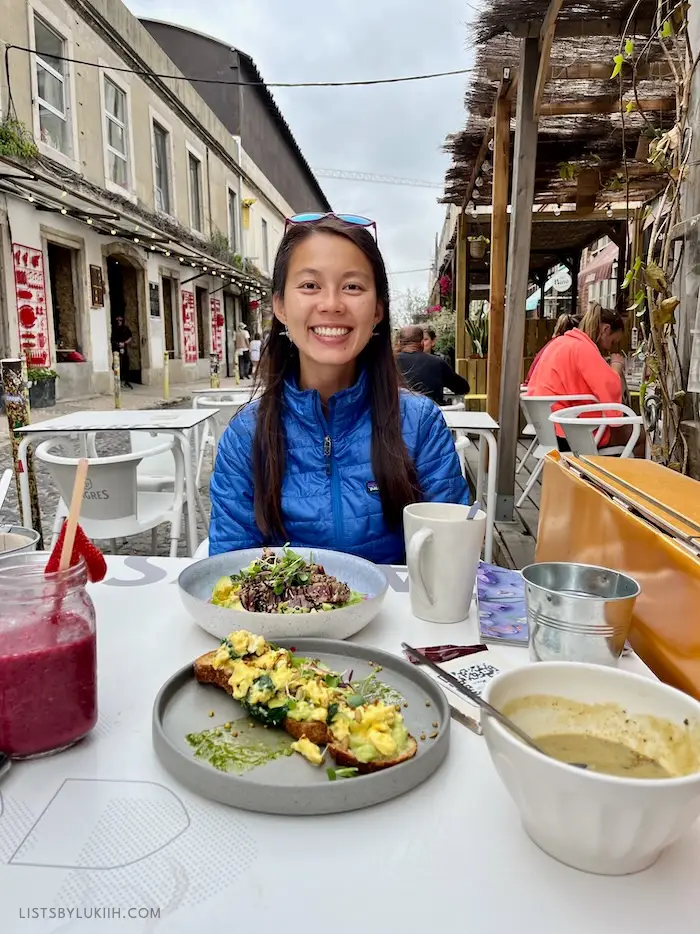
🎟️ 3. Evaluate whether the tourist cards are worth it.
Portugal’s top two destinations, Lisbon and Porto, offer visitor cards:
- The Lisboa Card gives you free access to public transportation, 30+ museums, and other tourist attractions.
- The Porto Card offers similar discounts and benefits.
All my travel expenses are detailed in this Portugal cost breakdown.
🚇 4. Take advantage of Portugal’s public transportation system.
Lisbon and Porto have well-maintained metros that connect to many top attractions. You can also take a convenient three-hour train between the two cities.
A rental car is only needed if you plan a more off-the-beaten-path road trip.
Learn more about getting around Portugal.
🧳 5. It’s worth paying for luggage storage.
If you don’t have immediate access to your accommodation, pay for luggage storage. It’s a pain to drag luggage around the hills and cobblestone sidewalks, no matter your fitness level.
I used Luggage @ City Center in Lisbon, and they offered reasonable prices and good customer service.

🧥 6. Pack layers for the temperature fluctuations.
Portugal has consistently sunny, mild weather year-round, but the temperature can fluctuate by as much as 20 °F throughout the day.
During the peak month of August, temperatures can be as high as 85 °F and drop to 65 °F at night.
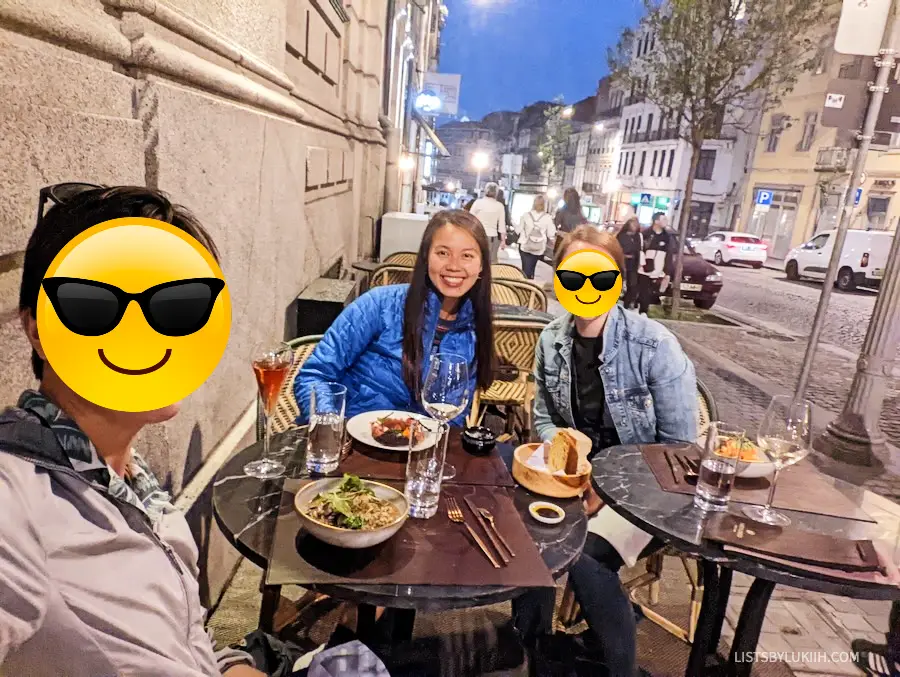
Learn other practical tips when traveling to Portugal.
Portugal Map
This map has all the recommended places in the Portugal itinerary below.
7-Day Itinerary for Portugal
Below is a great way to spend seven days in Portugal. To help you plan efficiently, I’ve included suggested times for each activity based on my firsthand experience.
The Portugal trip planner below has this itinerary prefilled.
| Day 1 – Lisbon (2 Days) | ||
| ✈️ | Arrive in Lisbon and take the metro to the city center | Morning |
| 🚶🏻♀️ | See Baixa-Chiado’s top attractions | 1–5 pm |
| ☀️ | Visit a miradouro for sunset | 6–7 pm |
| ☂️ | Go to Pink Street for its nightlife | After 8 pm |
| Day 2 – Lisbon (2 Days) | ||
| 🦞 | Eat at Time Out Market Lisboa | 12–1:30 pm |
| 🚂 | Take the vintage tram to Belém | 2–2:30 pm |
| ⛪️ | Explore Belém | 2:30–6:30 pm |
| ☀️ | Visit another miradouro for sunset | 6–7 pm |
| 🍹 | Check out Barrio Alto at night | After 8 pm |
| Day 3 – Sintra Day Trip | ||
| 🏰 | Take a day trip to Sintra | All day |
| Day 4 – Porto (2 Days) | ||
| 🛍️ | Walk around LX Factory | Morning |
| 🚊 | Take a train to Porto | 11:30 am–3 pm |
| 📚 | Visit Livraria Lello and Clérigos Tower | 3:30–5:30 pm |
| 💧 | Explore the Ribeira waterfront | 5:30–6:30 pm |
| 🎵 | Walk through Rua das Flores | 7–9 pm |
| Day 5 – Porto (2 Days) | ||
| 🦚 | Visit Crystal Palace Garden | 10 am–12 pm |
| 🚶🏻♀️ | Explore Porto’s city center | 1:30–5 pm |
| Day 6 – Douro Valley | ||
| 🍷 | Take a wine-tasting tour in Douro Valley | All day |
| Day 7 – Porto / Departure | ||
| 👟 | Cross the Luís I Bridge to explore Gaia | 12:30–4:30 pm |
| 🌅 | End your day at Parques da Virtudes | 5–6:30 pm |
| 🚂 | Alternatively, head back to Lisbon | All day |
All prices mentioned here are in USD 💵 .
Lisbon (Days 1-2)
Fly into Lisbon and start your Portugal trip there.
🌇 Why Visit Lisbon?
Lisbon, the capital city, is Portugal’s most visited destination and biggest city. There are many things to do and distinct districts worth visiting.
The vibrant cosmopolitan city is known for its historical buildings, beautiful viewpoints, and persistent sunny days.
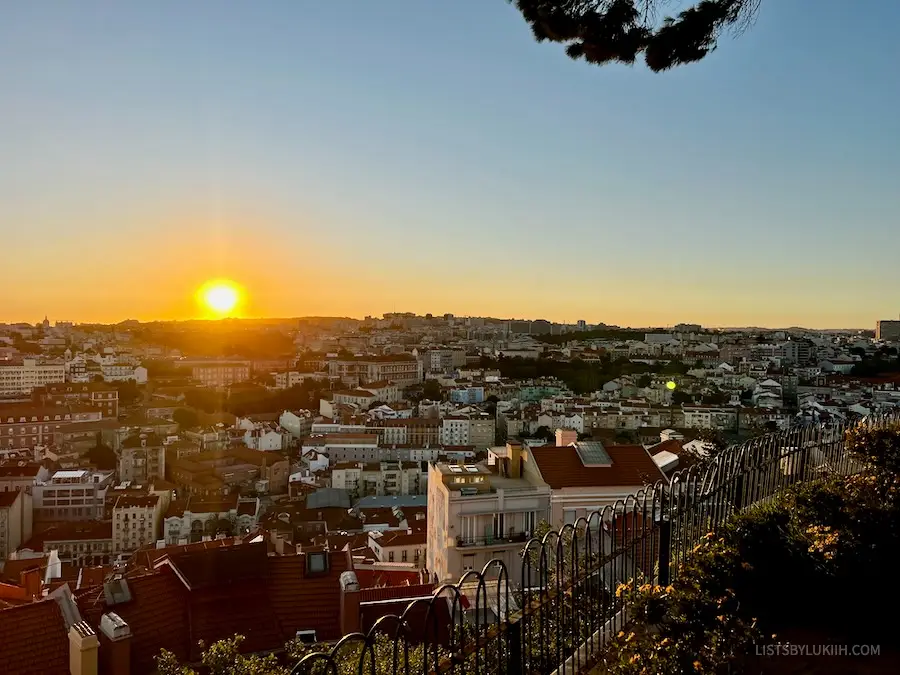
🚇 Getting to Lisbon
Lisbon is located on the western peninsula of Portugal. It’s home to one of Portugal’s main international airports, Humberto Delgado Airport, so most visitors fly into the city.
From the airport, you have two ways to get into Lisbon:
- Metro – Lisbon’s metro takes you into the city in less than 30 minutes. I took it from the airport to the Alfama district and found it convenient and easy to navigate.
- Taxi or Uber – You can also take a 20-minute taxi or Uber ride from the airport into the city, but that will cost significantly more (at least $30).
⭐️ Top Attractions in Lisbon
Here are some of Lisbon’s main attractions and best things to do:
- Baixa-Chiado – The city center is known as the shopping and commercial district with several notable attractions, including the historic Arco da Rua Augusta, the extremely popular Santa Justa Lift, and Praça do Comércio, one of Europe’s biggest squares.
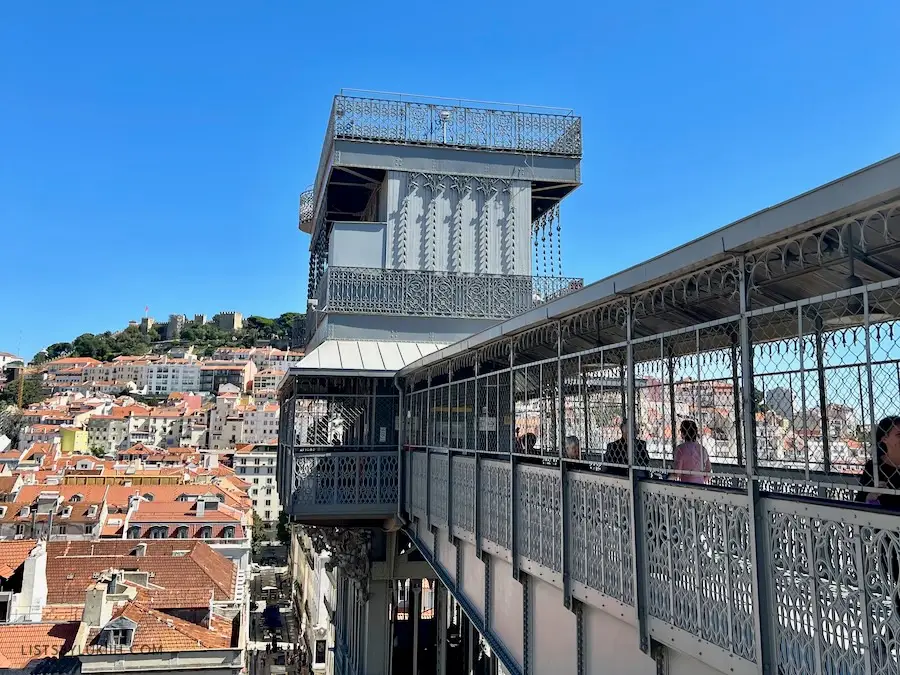
- Miradouros – Lisbon is known for its panoramic viewpoints called miradourous. They are typically located on the highest hills of the surrounding area and are most popular during sunsets.
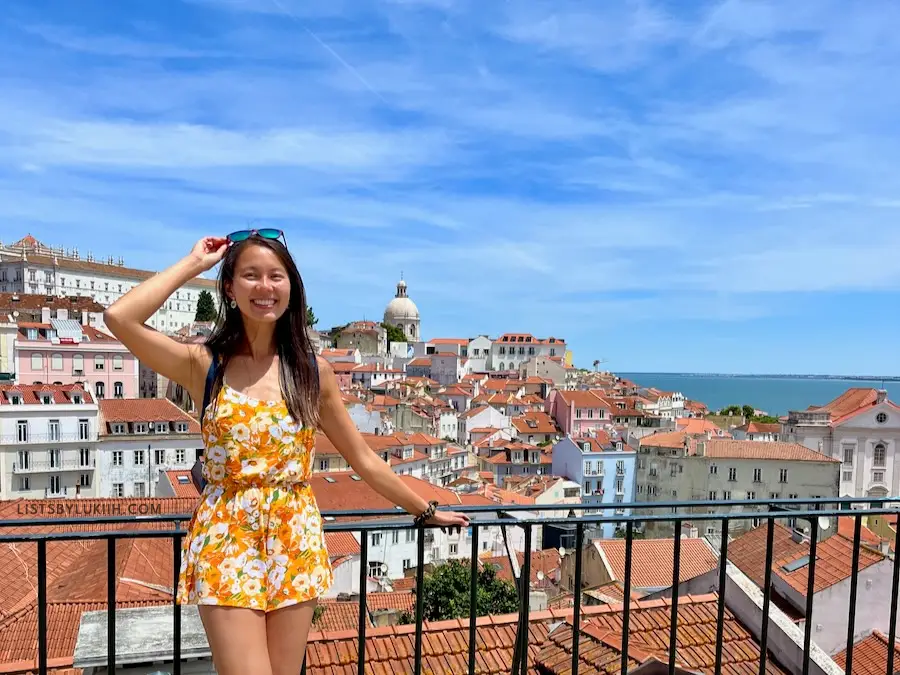
- Nightlife scene – The historic town of Bairro Alto and the famous Pink Street are Lisbon’s two most popular nightlife districts. Both areas are lined with restaurants and bars open late into the night.
- Belém – Located next to the Tagus River, Belém District is home to the Jerónimos Monastery, an architectural marvel, and the Belem Tower, a UNESCO World Heritage Site.
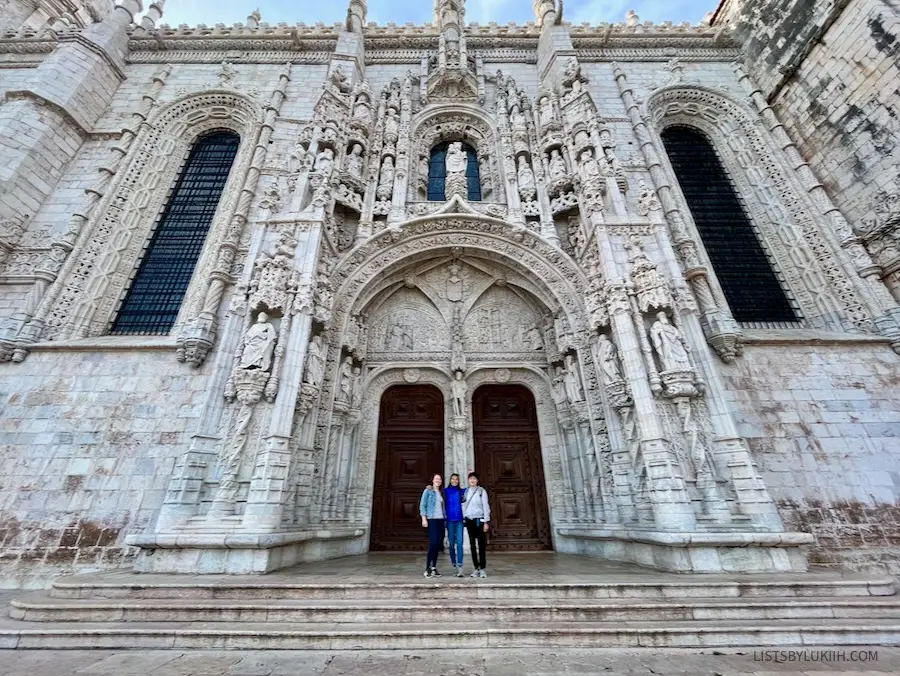
- Trendy shopping areas – Lisbon also boasts trendy shopping and dining areas like the LX factory and Time Out Market.
Learn more about Lisbon’s top attractions in detail.
🏠 Where To Stay in Lisbon
Where you should stay in Lisbon depends on your interests and preferred atmosphere:
- Baixa and Chiado – These two districts are great for first-time visitors, as you’ll be close to where all the main attractions are.
- Alfama – Alfama is the perfect district for those who want a more charming atmosphere. I stayed in Alfama and loved the quieter streets with the occasional cafe.
- Belem – Belem has wider streets, is next to the river, and has more museums if that’s your cup of tea.
- Bairro Alto – For those planning to stay out late to enjoy Lisbon’s busy nightlife, Bairro Alto is a great option for where to stay.
🍀 Lukiih’s Tips for Lisbon
Here are my general tips for visiting this city:
- Visit five neighborhoods for a complete trip – Lisbon’s districts each take half a day to a full day to explore. Prioritize the five most popular neighborhoods to get a complete feel for the city: Belém, Baixa, Chiado, Bairro Alto, and Alfama. All five neighborhoods are featured in this Portugal itinerary.
- Spend more time in Porto than in Lisbon – Porto is more unique and charming. However, if you enjoy bigger cities and more nightlife, you should spend more time in Lisbon.
Sintra (Day 3)
On your third day in Portugal, travel west for a day trip in Sintra.
🏰 Why Visit Sintra?
Sintra is a picturesque small town near Lisbon and one of Portugal’s UNESCO World Heritage Sites.
It’s known as one of the best day trips from Lisbon and features fairytale-like palaces, gardens, and town center.
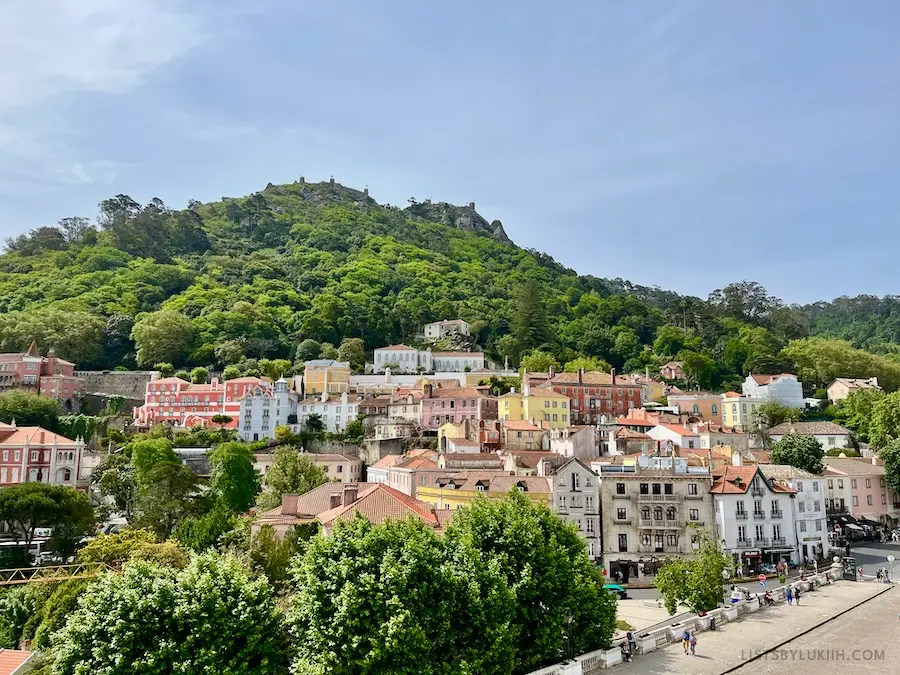
🚌 Getting to Sintra
Sintra is a 30-minute drive west of Lisbon, so it’s most commonly visited as a day trip from the capital city.
There are three ways to get to and around Sintra:
- Public transportation – The budget option is to take the CP train to Sintra and then rely on the shuttle bus to get around town.
- Taxi or Uber – A taxi or Uber from Lisbon to Sintra can cost over $100, so this is the most convenient option if you’re traveling with a group and can split the cost. This is how my sister got to Sintra.
- Organized tour – The most convenient option is to take a highly-rated Sintra guided tour that provides transportation. This usually costs about $90, and that’s how I got to Sintra.
Learn how to get to and around Sintra in detail.
⭐️ Top Attractions in Sintra
Sintra has several meaningful attractions that can be visited in a day:
- Pena Palance – One of the Seven Wonders of Portugal and Sintra’s most popular attraction, Pena Palace stands out with its colorful and photogenic exterior.
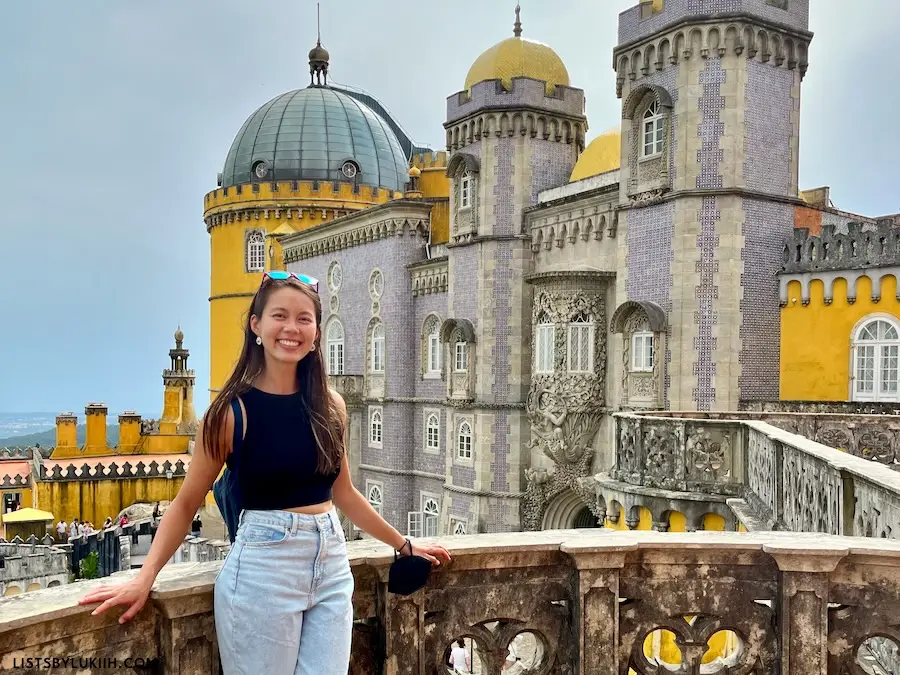
- Castelo dos Mouros – A national monument, the Moorish Castle is a medieval castle with breathtaking views.
- Quinta da Regaleira – Featuring stunning gardens, Quinta da Regaleira is a unique estate with the famous Initiation Well.
Learn more about Sintra’s attractions in detail.
🍀 Lukiih’s Tips for Sintra
Sintra is a great place to visit after exploring Lisbon for a change of scenery. It was one of the highlights of my Portugal trip, and I wished I had spent more time there.
Here are my general tips for visiting this city:
- Consider an overnight stay – If you enjoy picturesque towns and views, it might be worth staying longer. However, a day trip to Sintra is sufficient if you prefer the city landscapes of Lisbon.
- Don’t skip the coastlines or beach times – Sintra is located near the coast that faces the Atlantic Ocean. While you can spend your entire time in Sintra, it’s a good idea to check out places like Cabo da Roca. Most Sintra guided tours include a stop near the ocean.
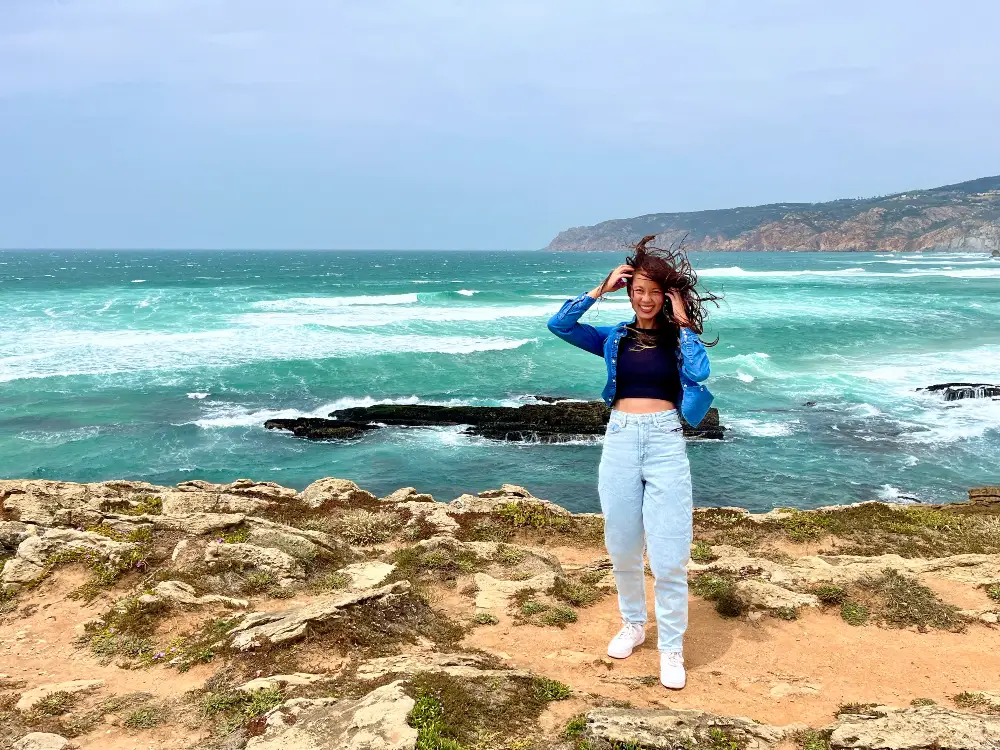
Porto (Day 4-5)
On the fourth day, head north to Porto after grabbing brunch in Lisbon.
🎶 Why Visit Porto?
Porto is the second largest city in Portugal. It’s known for its port wine, rich history, riverfront views, and buildings decorated with blue ceramic tiles known as “azulejos.”
Although Porto is often a secondary destination to Lisbon, I liked Porto more because it had a more contained, charming, and authentic atmosphere.

🚇 Getting to Porto
Porto, in northern Portugal, has an international airport, Francisco Sá Carneiro Airport, but most visitors arrive from Lisbon. From the airport, you can take a 25-minute bus or an hour-long metro ride into the city center.
Porto is a three-and-a-half-hour train ride north of Lisbon. You can take the state-owned train, Comboios de Portugal (CP), which is what I did.
The train can drop you off at São Bento station, which is not only an attraction in itself but is also a walking distance from the city center.
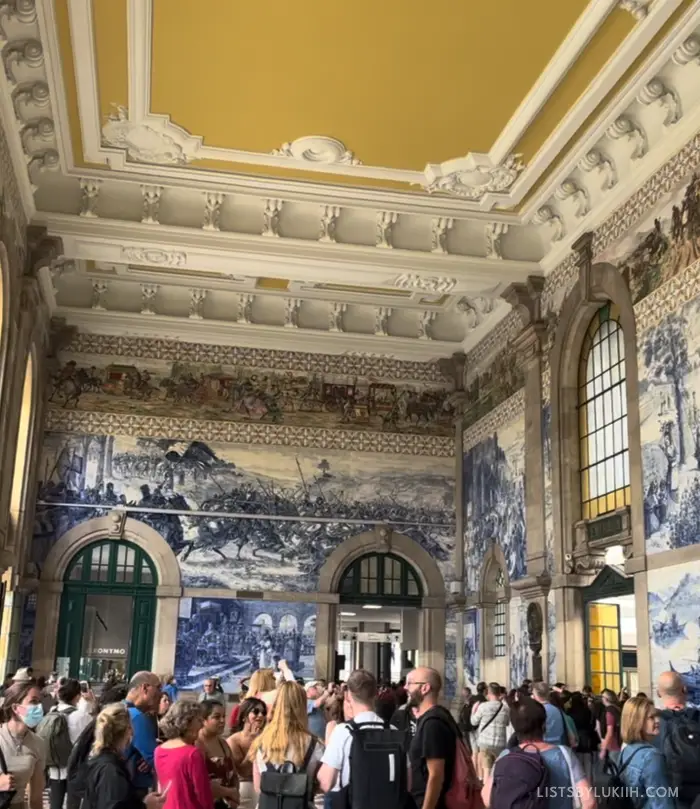
⭐️ Top Attractions in Porto
Porto has several attractions and sightseeing areas:
- Livraria Lello – Livraria Lello is considered one of the world’s most beautiful bookstores. Harry Potter fans and others flock to it because it’s said to have inspired Hogwarts Library.
- São Bento – This is Porto’s central train station, and its facade is famous because it’s adorned with 20,000 azulejos, which are blue-ceramic tiles.
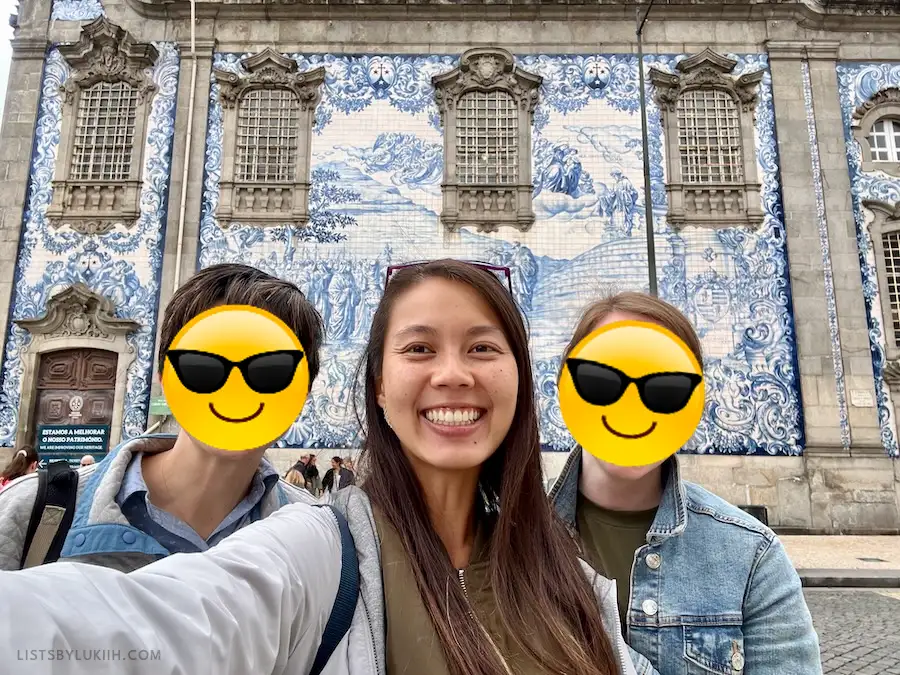
- Ribeira District – This photogenic area by the river is known for its waterfront views and busy shops.
- Gaia – Vila Nova de Gaia is known for its Port wine cellars, and it’s a great place to spend at least half a day.

- Clerigos Tower – This is Porto’s iconic bell tower. Visitors willing to climb up its steps are rewarded with a great view of the city and the Douro River.
- Crystal Palace Gardens – Located a bit outside Porto’s city center, Crystal Palace Gardens is known for its free-roaming peacocks.
- Rua das Flores – A notable landmark street in Porto, Rua das Flores is lined with picturesque shops, cafes, and restaurants. The street is pedestrian-friendly and has live music at night.
Learn more about Porto’s attractions in detail.
🏠 Where To Stay in Porto
Porto has several areas to choose from on where to stay:
- Baixa – Baixa is Porto’s city center and the best place to stay if you want to be within walking distance of all the top attractions. I stayed a bit south of Baixa and could get to the São Bento train station in ten minutes, which was convenient.
- Ribeira – Located near the river, Ribeira is a good place to stay if you want to maximize Porto’s historic charm.
- Gaia – Vila Nova de Gaia is technically outside of Porto, but it’s within walking. Stay here if you plan to drink a lot of wine and want to be near the river.
🍀 Lukiih’s Tips for Porto
Here are my general tips for visiting this city:
- Spend some time wandering around – Porto has its fair share of major attractions, but it’s also the perfect place to walk around to see more local areas like Parques da Virtudes.
- Enjoy the evening music – One of my favorite things about Porto was wandering the city center at night when everyone was dining out in the streets and enjoying live music. Even if you walk through the city center during the day when all the shops are open, make sure to also check it out at night.
Douro Valley (Day 6)
On your second to last day in Portugal, head to the Douro Valley.
🍷 Why Visit Douro Valley?
Douro Valley is a UNESCO World Heritage Site and the exclusive producer of Port wine, which Portugal is known for.
The Portugal section of the Douro Valley is one of the country’s best day trips outside Porto.
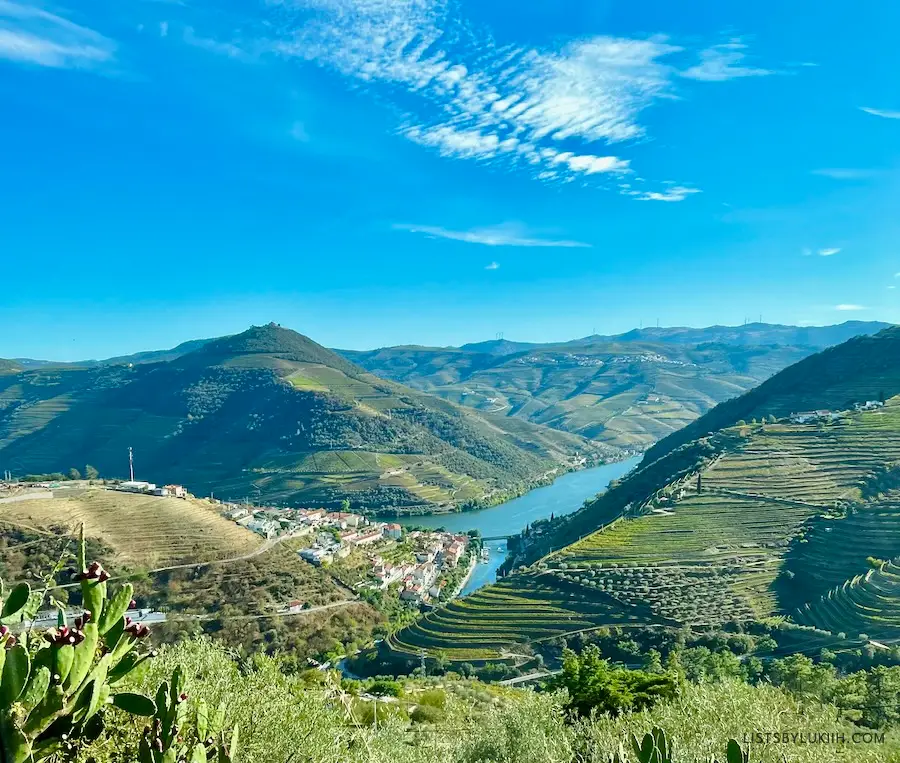
🚐 Getting to Douro Valley
The Douro Valley runs along the Douro River and is surrounded by several vineyards. The valley is a region and not a precise location, so how you reach the Douro Valley depends on your preferred activity.
In general, there are four ways to visit the Douro Valley:
- Rental car – Drive along National Highway 222 for a scenic road trip. Note that some of the roads you’ll encounter are steep and winding.
- Boat ride – You can take a boat that takes you down the river.
- Organized tour – Porto has several operators that take you to a vineyard or two.
- Train – Porto’s train runs along the river. You can take a train from São Bento station heading towards Pochinho.
⭐️ Top Attractions in Douro Valley
The most popular thing to do in the Douro Valley is to go wine-tasting at the famous vineyards, which are the exclusive producers of sweet Port wine.
For most visitors, the most convenient way to visit the vineyards is through a full-day wine tour of the Douro Valley. This tour usually includes a boat ride down the river as well.
Otherwise, the scenic drive or train ride next to the river can be an activity in itself.
Depart from Lisbon or Porto (Day 7)
On your last day in Portugal, you have two options:
- Stay in Porto – You can spend a half-day in the Gaia district for more riverfront reviews, a short hike up to a garden with a scenic view, and a cable car ride.
- Return to Lisbon – Take the train back to Lisbon in the morning and spend the afternoon visiting a neighborhood you didn’t get to during the first two days.
How much will a trip set you back? I share my travel expenses in this Portugal budget breakdown.
With More Time in Portugal
If you have a few extra days in Portugal, extending your time and modifying the itinerary above is easy.
🏝️ Option 1: Algarve Region
From Lisbon, you can head south and visit the Algarve region, which is a four-hour train ride away.
The Algarve region is known for its beautiful beaches, charming towns, and stunning coastline. You can spend two to three days there.
🪴 Option 2: Coimbra
From Porto, you explore Coimbra in central Portugal. Coimbra is located two hours south of Porto.
Coimbra is a good option if you want to see more historic architecture, enjoy Fado, a traditional Portuguese music genre, or visit one of the oldest botanical gardens in Europe.
Portugal Trip Planner 2024
To make your travel planning easier, download the trip planner below and use it as a starting point. The planner has country-specific travel information, an itinerary, a packing list, and a map with key places pinned.
The trip planner is built on Notion, which I use for all my travel planning (I genuinely love this tool). If you don’t have Notion, creating an account is free.
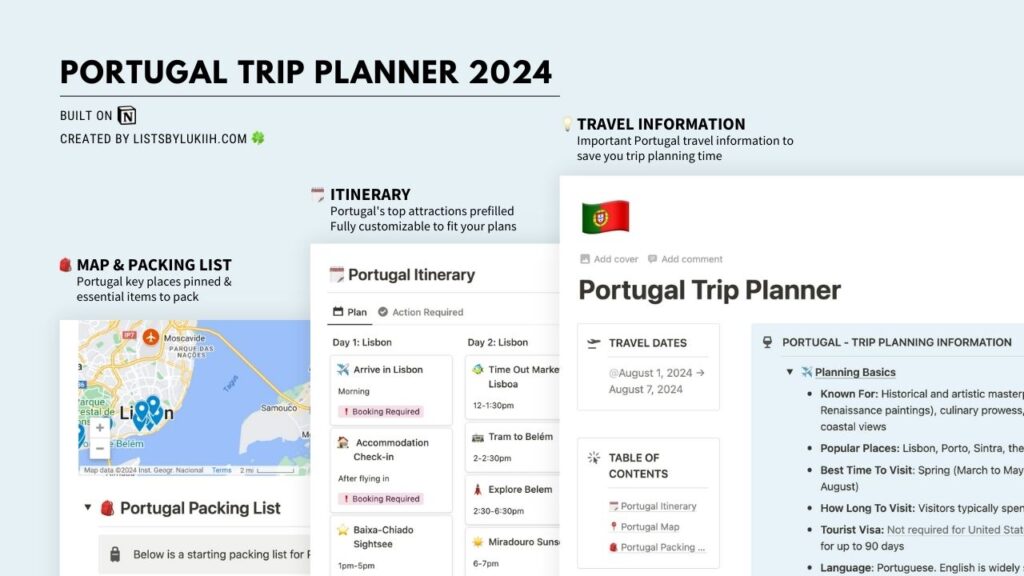
Portugal Travel Guides
- 🇵🇹 Planning A Trip to Portugal: 10 Practical Things To Know
- ☀️ 7 Amazing Days in Portugal: An Efficient Itinerary
- 🏰 One Epic Day in Sintra From Lisbon: Efficient Itinerary
- ⛅ Lisbon Guide: 4-Day Itinerary + 10 Great Things To Do
- 🍷 Porto Guide: 3-Day Itinerary + 11 Top Things To Do
- 💰 My Portugal Trip Cost: Budget Breakdown (2025)
🧋 Support Lukiih
Lists by Lukiih is a humble website that I fund with my own savings. If you find my tips helpful, I appreciate you saying thanks with a bubble tea!